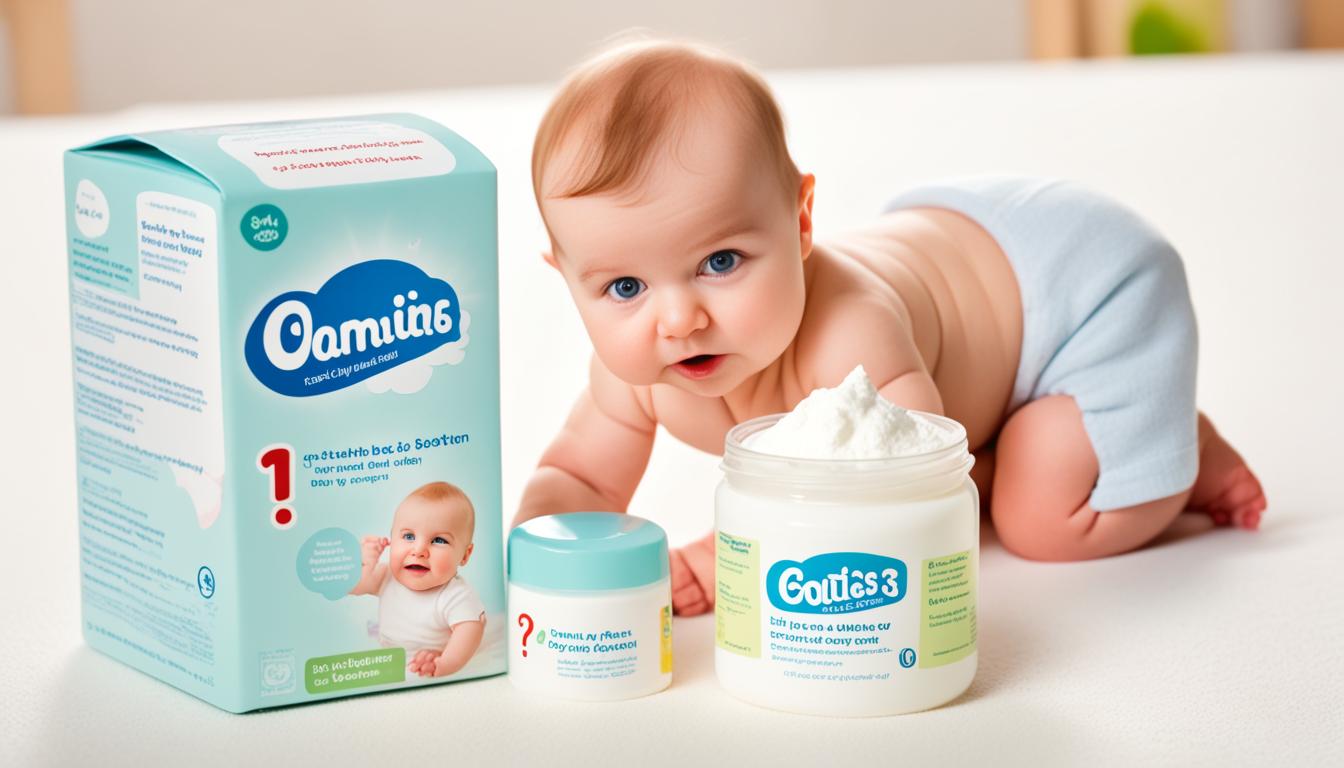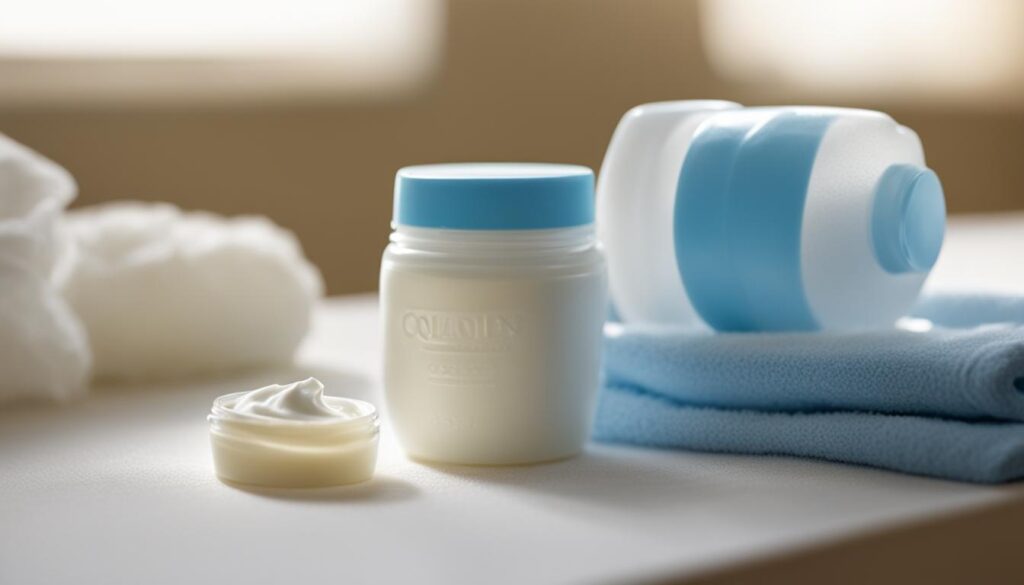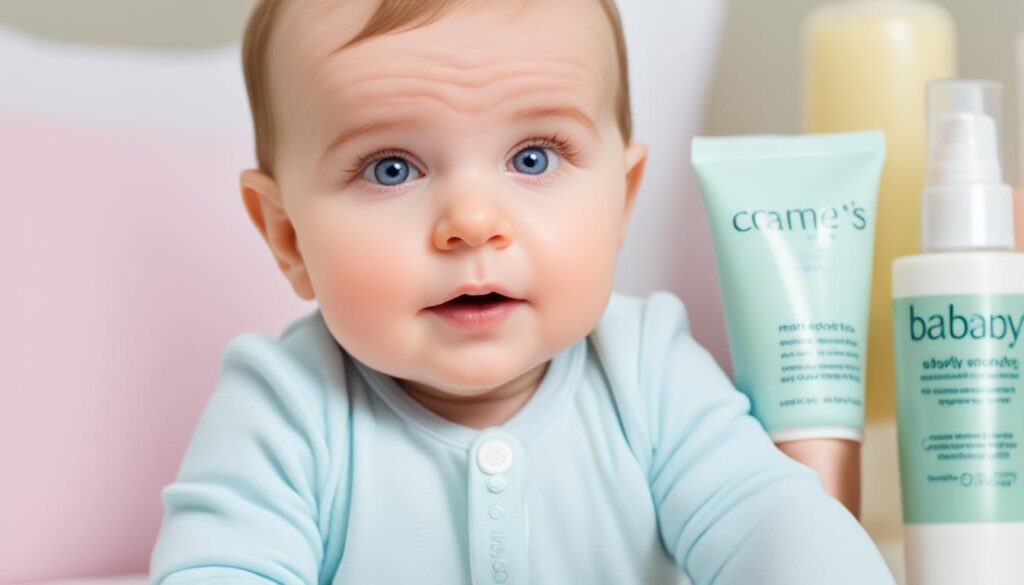When it comes to caring for your baby’s delicate skin, it’s important to make informed choices. One common dilemma parents face is whether to use diaper cream or baby powder. Both products have their benefits and drawbacks, and selecting the right one can make a difference in preventing and treating diaper rash.
Diaper rash is a common condition that can cause discomfort for infants and anxiety for parents. Understanding the options available for treatment and prevention is essential. In this article, I will discuss the benefits and drawbacks of diaper cream and baby powder, helping you make an informed decision regarding your baby’s skincare regimen.
Key Takeaways:
- Diaper cream is specifically designed to treat and prevent diaper rash, providing a protective barrier for your baby’s skin.
- Baby powder, especially those containing talcum powder, may pose health risks such as respiratory irritation and a potential link to cancer.
- Cornstarch, often considered a safer alternative to talcum powder, carries its own risks if inhaled and may potentially worsen yeast infections.
- The American Academy of Pediatrics recommends avoiding baby powders and focusing on keeping the diaper area clean and moisturized.
- Minimizing the use of products and prioritizing moisturization is vital for maintaining healthy skin in the diaper area.
- Consider NOLEO 3-in-1 as a safer alternative to baby powder, combining cleansing, moisturizing, and diaper rash prevention in one product.
What is Diaper Rash?
Diaper rash, also known as irritant diaper dermatitis, is a common condition that affects infants. It presents as a red irritation on the skin in the diaper area and can vary in severity. Diaper rash can include symptoms such as scaling, blistering, ulcers, bumps, pimples, or sores. In some cases, candidal colonization may occur, which requires medical attention. It’s important to treat diaper rash safely to avoid further discomfort and complications.
Diaper rash, or irritant diaper dermatitis, is a form of skin irritation that can affect infants. It is characterized by redness, scaling, and other manifestations of inflammation in the diaper area. In more severe cases, the affected skin may develop blisters, ulcers, bumps, pimples, or sores. Candidal colonization, which is the growth of yeast on the skin, can also occur in diaper rash and requires medical attention.
Safe treatment of diaper rash involves protecting the skin and providing relief from discomfort. Understanding the causes and manifestations of diaper rash is essential in effectively managing it. By identifying the symptoms and implementing proper care, parents can ensure their baby’s well-being.
Understanding Diaper Cream
Diaper cream is an essential product for treating and preventing diaper rash in babies. It is specifically designed with safe ingredients that act as protectants for the delicate baby skin. Diaper cream creates a protective barrier that excludes irritants, removes wetness, and shields the skin from friction caused by contact with opposing skin.
When choosing a diaper cream, it’s crucial to opt for one that suits your baby’s needs and is free from harmful ingredients. Look for specific protectant ingredients that are known to be safe and effective in treating diaper rash. Some of these ingredients include:
- Allantoin: A natural plant-based compound with moisturizing and soothing properties.
- Calamine: Known for its soothing and anti-itch properties, calamine helps alleviate discomfort caused by diaper rash.
- Dimethicone: Creates a protective barrier on the skin’s surface, preventing irritation and locking in moisture.
- Kaolin: A gentle clay that helps absorb excess moisture and promotes healing.
- Cod liver oil: Rich in nutrients and essential fatty acids, cod liver oil helps nourish and protect the skin.
- Zinc oxide: One of the most common diaper cream ingredients, zinc oxide forms a protective barrier and has antimicrobial properties.
To ensure the safety and well-being of your baby, choose a diaper cream that contains these specific protectant ingredients. Avoid creams that contain harmful substances and prioritize products with natural and gentle formulations.
“Diaper cream acts as a protectant, creating a barrier to exclude irritants, remove wetness, and shield skin.”
Diaper cream plays a crucial role in maintaining your baby’s skin health by treating and preventing diaper rash. Its safe ingredients and effective protectant properties offer relief and protection for your little one’s delicate skin.
The Dangers of Baby Powder
Traditional baby powders often contain talcum powder, which has been associated with serious health risks. Talcum powder can potentially contain asbestos, a known carcinogen, and can cause respiratory irritation when inhaled. Studies have linked talcum powder to an increased risk of lung and ovarian cancer. It’s especially concerning to use talcum powder on a baby’s delicate skin, as their lungs are more susceptible to irritation.
As I mentioned earlier, baby powder can pose significant safety concerns and it’s essential to be aware of these dangers for the well-being of your child. Fortunately, there are safer alternatives available that can help protect your baby’s health.
“The use of talcum powder in baby products has been linked to serious health concerns, including cancer risks and respiratory irritation. It’s crucial for parents to educate themselves about these potential dangers and take steps to protect their child’s health.”
I’d like to emphasize, if you have been using baby powder on your child, it’s important to discontinue its use and look for alternative options to keep your baby comfortable and safe. In the next section, I will discuss a safer alternative to baby powder that you can consider for your baby’s skincare routine.
Is Cornstarch a Safer Alternative?
When it comes to choosing a baby powder alternative, many parents turn to cornstarch. Cornstarch is often considered a safer option because it does not contain talc, which has been linked to health risks. However, it’s important to understand the potential risks and drawbacks of using cornstarch before making a decision.
Cornstarch can be a useful tool for keeping your baby’s skin dry and preventing diaper rash. It has absorbent properties that help to wick away moisture and reduce friction. This can be particularly beneficial for babies with sensitive skin.
However, there are potential concerns with using cornstarch, especially when it comes to inhalation risks. When cornstarch is used as a powder, it can become airborne and easily inhaled. Inhalation of cornstarch powder can irritate the respiratory system and lead to breathing difficulties, particularly in babies with respiratory conditions.
Moreover, cornstarch can potentially worsen yeast infections and yeast-related diaper rash. Yeast thrives in warm and moist environments, and cornstarch can create the ideal conditions for yeast growth. If your baby is prone to yeast infections or has a history of diaper rash caused by yeast, it may be best to avoid using cornstarch.
While some parents claim that cornstarch is safe for diaper use, it’s important to weigh the potential risks and consider other alternatives for keeping your baby’s skin dry and preventing diaper rash.
The American Academy of Pediatrics’ Recommendation
The American Academy of Pediatrics (AAP) provides valuable diaper care guidelines to help parents maintain their baby’s skin health. According to the AAP, it is important to avoid using cornstarch or talc-based baby powders when changing a diaper. Instead, the focus should be on keeping the diaper area clean and moisturized using simple, natural products.
When changing your baby’s diaper, it is crucial to promptly remove and replace it when it is soiled. This helps prevent prolonged exposure to moisture and potential irritation. Thoroughly cleaning the diaper area with a gentle cleanser and warm water can help remove any dirt or bacteria that may contribute to diaper rash.
After cleansing, it is recommended to moisturize the skin with a gentle, hypoallergenic moisturizer. This helps maintain the skin’s natural moisture barrier and prevent dryness, which can lead to irritation. Keeping the diaper area clean and moisturized is essential for preventing diaper rash and maintaining your baby’s skin health.
Following these guidelines provided by the American Academy of Pediatrics can help you make informed decisions about diaper care and avoid the need for additional products that may contain potentially harmful ingredients. It’s important to prioritize your baby’s well-being and take the necessary steps to protect their delicate skin.
With the focus on keeping the diaper area clean and moisturized, you can provide the best care for your baby’s skin and reduce the risk of diaper rash.
Moisturized Skin Equals Healthy Skin
Contrary to popular belief, keeping the diaper area dry is not the best approach for maintaining healthy skin. Dry skin is more susceptible to chafing and irritation, which can lead to diaper rash. Instead, it’s important to keep the skin moisturized to maintain its health.
Applying too many products to your baby’s skin can disrupt their skin microbiome, which is a delicate balance of good and bad bacteria. Minimizing the use of products and focusing on proper cleansing and moisturizing is key to maintaining healthy skin.
One way to ensure your baby’s skin stays moisturized is to choose a diaper cream that not only protects against diaper rash but also moisturizes the skin. Look for diaper creams that contain ingredients like shea butter, coconut oil, or aloe vera, which are known for their moisturizing properties.
“I always make sure to apply a generous amount of diaper cream on my baby’s skin. It keeps their skin moisturized and prevents diaper rash. I love the way their skin feels soft and smooth,” says Emily, a mom of two.
Benefits of Moisturized Skin:
- Prevents chafing and irritation
- Maintains the skin’s natural barrier
- Helps soothe and heal existing diaper rash
- Keeps the skin soft and supple
- Reduces the risk of future diaper rash
Remember, maintaining healthy skin is not about using multiple products, but about focusing on the essentials. Keep your baby’s diaper area clean and moisturized, and choose a diaper cream that provides both protection and hydration. By prioritizing moisturized skin, you can minimize the risk of diaper rash and ensure your baby stays comfortable and happy.
What to Use Instead of Baby Powder
When it comes to your baby’s diaper changing routine, it’s important to prioritize their delicate skin and choose safe alternatives to baby powder. One such alternative that combines cleansing, moisturizing, and treating/preventing diaper rash is NOLEO 3-in-1.
NOLEO 3-in-1 is a non-toxic product made with carefully selected, safe ingredients. It eliminates the need for multiple products, simplifying your diaper changing routine while providing gentle care for your baby’s skin.
By using NOLEO 3-in-1, you can cleanse your baby’s skin, moisturize it, and effectively treat and prevent diaper rash. It’s a convenient solution that saves you time and offers peace of mind, knowing that you’re using a product that is specifically designed for your baby’s needs.
“NOLEO 3-in-1 has been a game-changer for me and my baby’s diaper changing routine. It’s a one-stop solution that nourishes and protects my baby’s skin. I love how gentle and effective it is!”
– Sarah, a satisfied NOLEO customer
With NOLEO 3-in-1, you can confidently say goodbye to baby powder and embrace a safer and more efficient way to care for your baby’s delicate skin. Its all-in-one formulation provides the necessary cleansing, moisturizing, and diaper rash treatment/prevention, giving you peace of mind and your baby the care they deserve.
Experience the benefits of NOLEO 3-in-1 for yourself and discover a better alternative to baby powder!
Conclusion
When it comes to taking care of your baby’s delicate skin, choosing the right products is essential. In the debate between diaper cream and baby powder, the clear winner for treating and preventing diaper rash is diaper cream. With its safe and effective ingredients, diaper cream provides the necessary protection and relief for your baby’s skin.
Baby powder, on the other hand, poses potential risks, such as respiratory irritation and the link to cancer through talcum powder. It’s best to avoid using baby powder altogether to protect your baby’s health and well-being.
To provide the best care for your baby’s skin, it’s important to follow the recommendations of the American Academy of Pediatrics. They advise avoiding cornstarch or talc-based baby powders and instead focus on keeping the diaper area clean and moisturized. By following these guidelines and considering alternative products like NOLEO 3-in-1, you can prevent diaper rash and ensure your baby’s skin stays healthy and protected.
FAQ
Should I use diaper cream or baby powder?
What is diaper rash?
What is diaper cream?
What are the dangers of baby powder?
Is cornstarch a safer alternative to baby powder?
What is the recommendation from the American Academy of Pediatrics?
Why is moisturized skin important for preventing diaper rash?
What can I use instead of baby powder?
Which is better, diaper cream or baby powder?
Source Links
- https://www.uspharmacist.com/article/helping-parents-treat-diaper-rash
- https://community.whattoexpect.com/forums/january-2013-babies/topic/silly-question-baby-powder-vs-diaper-ointment-cream.html
- https://www.noleocare.com/blogs/news/why-experts-advise-against-using-baby-powder-or-cornstarch-on-the-diaper-area



